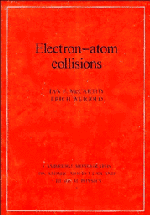Book contents
- Frontmatter
- Contents
- Preface
- 1 Introduction
- 2 Experimental techniques for cross-section measurements
- 3 Background quantum mechanics in the atomic context
- 4 One-electron problems
- 5 Theory of atomic bound states
- 6 Formal scattering theory
- 7 Calculation of scattering amplitudes
- 8 Spin-independent scattering observables
- 9 Spin-dependent scattering observables
- 10 Ionisation
- 11 Electron momentum spectroscopy
- References
- Index
9 - Spin-dependent scattering observables
Published online by Cambridge University Press: 15 December 2009
- Frontmatter
- Contents
- Preface
- 1 Introduction
- 2 Experimental techniques for cross-section measurements
- 3 Background quantum mechanics in the atomic context
- 4 One-electron problems
- 5 Theory of atomic bound states
- 6 Formal scattering theory
- 7 Calculation of scattering amplitudes
- 8 Spin-independent scattering observables
- 9 Spin-dependent scattering observables
- 10 Ionisation
- 11 Electron momentum spectroscopy
- References
- Index
Summary
In the last chapter we discussed how our understanding of electron impact excitation of atoms has substantially improved in recent years. Sophisticated experimental techniques are available for revealing sensitive details of the collision process, in addition to providing accurate and reliable differential and total cross section data. These details include the shape and inherent angular momentum of the excited atoms after the scattering process, measured as a function of the scattering angle and incident energy. These studies have provided stringent tests of current scattering theories, particularly at intermediate energies and backward angles.
In conventional collision experiments the strong Coulomb interaction generally masks the much weaker relativistic spin-dependent interactions. The role of the spin-dependent interactions, such as the exchange and spin–orbit interactions, has also been clarified by sophisticated measurements with spin-polarised electrons and/or spin-polarised targets, sometimes employing spin analysis after the collision process (Kessler, 1985, 1991; Hanne, 1983).
Such measurements were first applied with considerable success to elastic scattering. Indeed one was able to discuss experiments which would determine all the theoretically calculable amplitudes (Bederson, 1970). For inelastic processes, such measurements necessitate the simultaneous application of spin selection techniques and the alignment and orientation measurements discussed in the previous chapter. The experiments have become feasible with the advancement of experimental techniques. The first successful differential electron impact excitation study with spin-polarised electrons and alignment and orientation measurements was performed by Goeke et al. (1983) for the e–Hg case.
- Type
- Chapter
- Information
- Electron-Atom Collisions , pp. 235 - 260Publisher: Cambridge University PressPrint publication year: 1995

